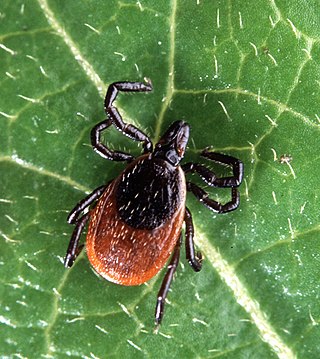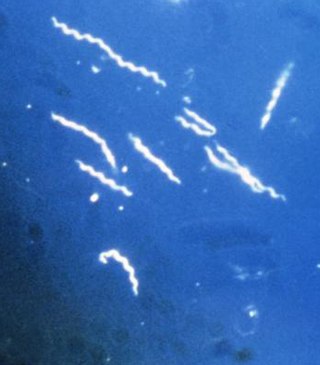
Ticks are parasitic arachnids that are part of the mite superorder Parasitiformes. Adult ticks are approximately 3 to 5 mm in length depending on age, sex, species, and "fullness". Ticks are external parasites, living by feeding on the blood of mammals, birds, and sometimes reptiles and amphibians. The timing of the origin of ticks is uncertain, though the oldest known tick fossils are from the Cretaceous period, around 100 million years old. Ticks are widely distributed around the world, especially in warm, humid climates.

The Ixodidae are the family of hard ticks or scale ticks, one of the three families of ticks, consisting of over 700 species. They are known as 'hard ticks' because they have a scutum or hard shield, which the other major family of ticks, the 'soft ticks' (Argasidae), lack. They are ectoparasites of a wide range of host species, and some are vectors of pathogens that can cause human disease.

Lyme disease, also known as Lyme borreliosis, is a vector-borne disease caused by Borrelia bacteria, which are spread by ticks in the genus Ixodes. The most common sign of infection is an expanding red rash, known as erythema migrans (EM), which appears at the site of the tick bite about a week afterwards. The rash is typically neither itchy nor painful. Approximately 70–80% of infected people develop a rash. Early diagnosis can be difficult. Other early symptoms may include fever, headaches and tiredness. If untreated, symptoms may include loss of the ability to move one or both sides of the face, joint pains, severe headaches with neck stiffness or heart palpitations. Months to years later, repeated episodes of joint pain and swelling may occur. Occasionally, shooting pains or tingling in the arms and legs may develop. Despite appropriate treatment, about 10 to 20% of those affected develop joint pains, memory problems, and tiredness for at least six months.
Tick-borne diseases, which afflict humans and other animals, are caused by infectious agents transmitted by tick bites. They are caused by infection with a variety of pathogens, including rickettsia and other types of bacteria, viruses, and protozoa. The economic impact of tick-borne diseases is considered to be substantial in humans, and tick-borne diseases are estimated to affect ~80 % of cattle worldwide.

Borrelia burgdorferi is a bacterial species of the spirochete class in the genus Borrelia, and is one of the causative agents of Lyme disease in humans. Along with a few similar genospecies, some of which also cause Lyme disease, it makes up the species complex of Borrelia burgdorferi sensu lato. The complex currently comprises 20 accepted and 3 proposed genospecies. B. burgdorferi sensu stricto exists in North America and Eurasia and until 2016 was the only known cause of Lyme disease in North America. Borrelia species are Gram-negative.

Ixodes holocyclus, commonly known as the Australian paralysis tick, is one of about 75 species in the Australian tick fauna and is considered the most medically important. It can cause paralysis by injecting neurotoxins into its host. It is usually found in a 20-kilometre wide band following the eastern coastline of Australia. Within this range Ixodes holocyclus is the tick most frequently encountered by humans and their pets. As this area also contains Australia's most densely populated regions, bites on people, pets and livestock are relatively common.

Dermacentor variabilis, also known as the American dog tick or wood tick, is a species of tick that is known to carry bacteria responsible for several diseases in humans, including Rocky Mountain spotted fever and tularemia. It is one of the best-known hard ticks. Diseases are spread when it sucks blood from the host. It may take several days for the host to experience symptoms.

Ixodiphagus hookeri, the tick wasp, is an encyrtid wasp which lays its eggs into ticks. It seems to use a symbiotic bacteria, Wolbachia pipientis, to weaken the tick's immune system.

Lyme disease, or borreliosis, is caused by spirochetal bacteria from the genus Borrelia, which has 52 known species. Three main species are the main causative agents of the disease in humans, while a number of others have been implicated as possibly pathogenic. Borrelia species in the species complex known to cause Lyme disease are collectively called Borrelia burgdorferisensu lato (s.l.) not to be confused with the single species in that complex Borrelia burgdorferi sensu stricto which is responsible for nearly all cases of Lyme disease in North America.

Ixodes is a genus of hard-bodied ticks. It includes important disease vectors of animals and humans, and some species inject toxins that can cause paralysis. Some ticks in this genus may transmit the pathogenic bacterium Borrelia burgdorferi responsible for causing Lyme disease. Additional organisms that may be transmitted by Ixodes are parasites from the genus Babesia, which cause babesiosis, and bacteria from the related genus Anaplasma, which cause anaplasmosis.

Ixodes scapularis is commonly known as the deer tick or black-legged tick, and in some parts of the US as the bear tick. It was also named Ixodes dammini until it was shown to be the same species in 1993. It is a hard-bodied tick found in the eastern and northern Midwest of the United States as well as in southeastern Canada. It is a vector for several diseases of animals, including humans and is known as the deer tick owing to its habit of parasitizing the white-tailed deer. It is also known to parasitize mice, lizards, migratory birds, etc. especially while the tick is in the larval or nymphal stage.

Ixodes ricinus, the castor bean tick, is a chiefly European species of hard-bodied tick. It may reach a length of 11 mm (0.43 in) when engorged with a blood meal, and can transmit both bacterial and viral pathogens such as the causative agents of Lyme disease and tick-borne encephalitis.

Amblyomma americanum, also known as the lone star tick, the northeastern water tick, or the turkey tick, is a type of tick indigenous to much of the eastern United States and Mexico, that bites painlessly and commonly goes unnoticed, remaining attached to its host for as long as seven days until it is fully engorged with blood. It is a member of the phylum Arthropoda, class Arachnida. The adult lone star tick is sexually dimorphic, named for a silvery-white, star-shaped spot or "lone star" present near the center of the posterior portion of the adult female shield (scutum); adult males conversely have varied white streaks or spots around the margins of their shields.
Ticks are insects known for attaching to and sucking blood from land-dwelling animals. Ticks fall under the category of 'arthropod', and while they are often thought of in the context of disease transmission, they are also known to cause direct harm to hosts through bites, toxin release, and infestation. Infestation can cause symptoms ranging from mild to severe and may even cause death. Hosts can include any number of vertebrates, though humans and livestock are more likely to be the interest of researchers.

Ixodes pacificus, the western black-legged tick, is a species of parasitic tick found on the western coast of North America. I. pacificus is a member of the family Ixodidae. It is the principal vector of Lyme disease in that region. I. pacificus typically feeds on lizards and small mammals therefore its rate of transmission of Lyme disease to humans is around 1% of adults. It is an ectoparasite that attaches itself to the outside of its host and feeds on the host's blood. It can have a heteroxenous lifestyle or monoxenous life cycle depending on how many hosts it feeds on in each cycle. I. pacificus has a four stage life cycle that takes around 3 years to complete. These stages include egg, larva, nymph, and adult. They prefer dense woodland habitats or areas of brush and tall grass.

Ixodes uriae, also known as the seabird tick, is a species of parasitic tick known to infest marine birds. It is native to many high latitude areas in the northern and southern hemispheres including Alaska, Canada, Faroe Islands, Iceland, Greenland, England, Scotland, Norway, Finland, the Kola Peninsula, Russia, Patagonia, South Africa and Australia.

Ixodes hexagonus, also known by the common name hedgehog tick, is a tick species in the genus Ixodes. It is a parasite of the European hedgehog.

Ticks of domestic animals directly cause poor health and loss of production to their hosts. Ticks also transmit numerous kinds of viruses, bacteria, and protozoa between domestic animals. These microbes cause diseases which can be severely debilitating or fatal to domestic animals, and may also affect humans. Ticks are especially important to domestic animals in tropical and subtropical countries, where the warm climate enables many species to flourish. Also, the large populations of wild animals in warm countries provide a reservoir of ticks and infective microbes that spread to domestic animals. Farmers of livestock animals use many methods to control ticks, and related treatments are used to reduce infestation of companion animals.
Borrelia mayonii is a Gram-negative, host-associated spirochete that is capable of causing Lyme disease. This organism can infect various vertebrate and invertebrate hosts such as humans and ticks, primarily Ixodes scapularis. Migratory songbirds play a role in the dispersal of the tick vector, Ixodes scapularis, across long distances, indirectly dispersing Borrelia mayonii as well.

Natalia Aleksandrovna Filippova was a world authority on the taxonomy of mites and especially ticks. Her monographs on the identification, morphology, development, distribution and behaviour of the family Argasidae and the sub-families of Ixodinae and Amblyomminae are standard works on these important vectors of disease.















